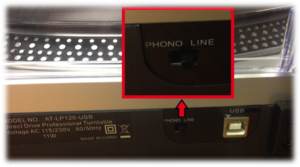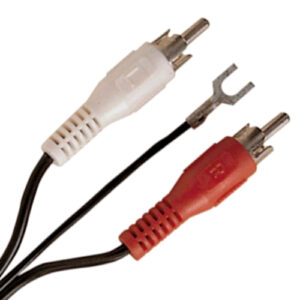How to connect your turntable to speakers
All Audio-Technica turntables have an analogue output and nearly all have an internal RIAA preamp, which allows the user to connect directly to powered speakers, or to passive speakers using an amplifier. Powered speakers are equipped with an internal power amplifier, their own power connection, and often a volume control. Passive speakers don’t include an amplifier and don’t have their own power source. In this case a stereo amplifier is required in between the turntable and the speakers to amplify the sound.
Most Audio-Technica turntables have a PHONO/LINE switch, with the exception of the AT-LP140XP, which only outputs at PHONO level as it is a professional DJ turntable and would ordinarily be used in conjunction with a mixer that has an integral PHONO preamp. The PHONO/LINE switch turns the turntable’s internal RIAA preamp off/on to provide the correct signal level for your turntable’s setup. It is important to understand when and why you would use each setting.

Line Level Output
When the turntable is set to LINE level, an internal RIAA preamp is being used. This allows the turntable to either plug directly into powered speakers, or into a stereo amplifier connected to passive speakers using any of the LINE level inputs, i.e. Aux, CD, Tape etc. Do not use the PHONO input as this will use the PHONO preamp in the stereo amplifier, as well as the turntable’s internal preamp. This will create a signal that is too high, which will distort the audio and could potentially damage the speakers and/or amplifier.
Phono Level Output
When the turntable is set to PHONO level the internal RIAA preamp, if present, is bypassed. This means the output signal is low and an external preamp is required to bring the signal up to LINE level. When using powered speakers, this may take the form of a small box that sits inline between the turntable the speakers. These vary vastly in price and quality so it is important to do some research before buying as it will affect the audio quality.
In a setup using passive speakers and a stereo amplifier, it is important to check that the amplifier has a dedicated PHONO channel. The PHONO channel has its own RIAA preamp and will bring the input signal up to LINE level. Plugging directly into a LINE level input will mean the audio will be very quiet, even if you turn the amplifier up high.
Quite often there needs to be a “ground” connection between the turntable and the preamp/amplifier to eliminate mains hum. Try playing a record with and without the ground connected and decide which gives the best performance. As most Audio-Technica turntables have an external power supply the ground connection may not be required.
Connectors
Audio Technica’s turntables either output on 3.5mm jack connector or via a dual phono connector. A relevant cable is provided with each turntable, though adaptors are sometimes required to connect to some equipment. Suitable adapters can be found easily in your local marketplace.

3.5mm jack connector

Dual phono connector with ground
Bluetooth output
When using a turntable with Bluetooth functionality, the integral phono pre-amplifier will need to be utilised as it is highly unlikely that the Bluetooth device receiving the signal will have one on-board. Audio Technica's selection of Bluetooth turntables require the PHONO/LINE switch to be in the LINE position in order to achieve this.
RIAA preamp background
Turntables require an RIAA preamp in order to properly reproduce the embedded content on a vinyl record. In the 1950s, the Recording Industry Association of America (RIAA) introduced an equalization standard that could be applied to the original audio as it was pressed into a record. This equalization, which continues to be used to this day, reduces low frequencies and boosts high frequencies, thereby compressing the audio so that more of it can fit on a record. During playback, the exact opposite function is performed through an RIAA preamp, resulting in the reproduction of the original audio.
If you have any further issues connecting your turntable or have any follow-up questions, we invite you to contact us so that we can offer you further advice.